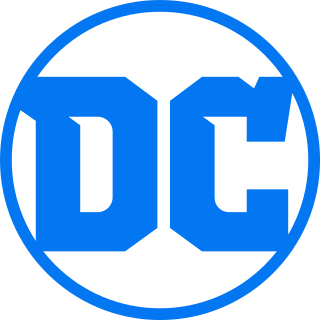
A superhero is a type of heroic stock character, usually possessing supernatural or superhuman powers, who is dedicated to fighting the evil of their universe, protecting the public, and usually battling super-villains. A female superhero is sometimes called a superheroine, although the word superhero is also commonly used for females. Superhero fiction is the genre of fiction that is centered on such characters, especially in American comic book and films since the 1930s.
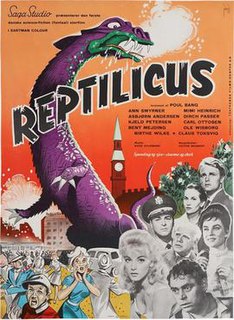
Reptilicus is a 1961 Danish-American giant monster film about a prehistoric reptile. The film was produced by American International Pictures and Saga Studio and separate versions were released in Denmark and in the United States.

Gorgo is a 1961 British-American science fiction monster film in Technicolor directed by Eugène Lourié. The film focuses on Gorgo, a young sea monster brought back to London for exploitation, and Ogra, his even larger mother, who rampages across London to search for him.
Godzilla has appeared in a range of comic books that have been published in Japan and the United States.
There have been three main publishers of the comic book series bearing the name Transformers based on the toy lines of the same name. The first series was produced by Marvel Comics from 1984 to 1991, which ran for 80 issues and produced four spin-off miniseries. This was followed by a second volume titled Transformers: Generation 2, which ran for 12 issues starting in 1993. The second major series was produced by Dreamwave Productions from 2002 to 2004 with multiple limited series as well, and within multiple story continuities, until the company became bankrupt in 2005. The third series is currently being produced by IDW Publishing starting with an issue #0 in October 2005 and a regular series starting in January 2006. There are also several limited series being produced by IDW as well. In addition to these three main publishers, there have also been several other smaller publishers with varying degrees of success.
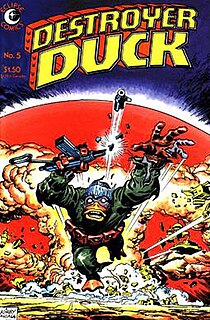
Destroyer Duck was an anthology comic book published by Eclipse Comics in 1982, as well as the title of its primary story, written by Steve Gerber and featuring artwork by Jack Kirby.

Tor is an American comics series, created by Joe Kubert and Norman Maurer in the story 1,000,000 Years Ago!, published by St. John Publications. The series' protagonist, Tor, is a prehistoric cave man who has fantasy adventures set in a realistically drawn setting. The original series only ran for five issues and ended in 1954. However, "Tor" was revived by DC Comics in June 1975 for six issues. In June 1993 Marvel Comics released new adventures of Tor.
The Grand Comics Database (GCD) is an Internet-based project to build a database of comic book information through user contributions. The GCD project is cataloging information on creator credits, story details, reprints, and other information useful to the comic book reader, comic collector, fan, and scholar. The GCD is a 501(c)(3) nonprofit organization incorporated in Arkansas.

Although fictional and the subject of myth, the legend of the Kraken continues to the present day, with numerous references existing in popular culture, including film, literature, television, video games, and other miscellaneous examples.

Chamber of Darkness is a horror/fantasy anthology comic book published by the American company Marvel Comics. Under this and a subsequent name, it ran from 1969 to 1974. It featured work by creators such as writer-editor Stan Lee, writers Gerry Conway, Archie Goodwin, and Roy Thomas, and artists John Buscema, Johnny Craig, Jack Kirby, Tom Sutton, Barry Windsor-Smith, and Bernie Wrightson. Stories were generally hosted by either of the characters Digger, a gravedigger, or Headstone P. Gravely, in undertaker garb, or by one of the artists or writers.

Throughout the decades King Kong has been featured in numerous comic book publications from numerous publishers.
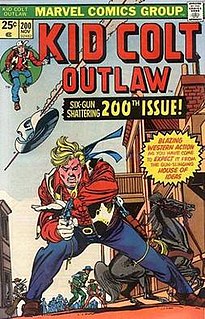
Kid Colt, Outlaw is a comic book title featuring the character Kid Colt originally published by Atlas Comics beginning in 1948 and later Marvel Comics.
Giant-killing or giant killer may refer to:

The Real Ghostbusters is a comic series spun off from The Real Ghostbusters animated series. Versions were published by Marvel UK and NOW Comics. Publication of the series began on March 28, 1988.
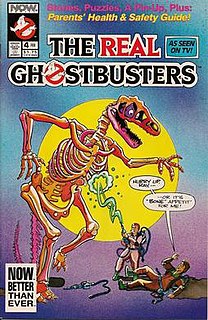
The Ghostbusters franchise spawned various comic books published by various comic book companies through the years starting in 1988 and continuing to the present day. These comics have ranged from being based on The Real Ghostbusters animated series, to the 1984 film.

Elmer Cecil Stoner was an American comics artist and commercial illustrator. Stoner was one of the first African-American comic book artists, and is believed to have created the iconic Mr. Peanut mascot. He produced pencil art for the first issue of Detective Comics, published by National Comics Publications, and worked for a variety of other golden age companies such as Timely Comics, Street & Smith, EC Comics, Fawcett Comics, and Dell Comics. Near the end of his life, Stoner was also a spokesman for Gordon's Gin.
Scribbly the Boy Cartoonist is a fictional character that has starred in his own comics book series. The series was introduced in anthology comic book series until his own series was launched. He is an semi-autobiographical character of his creator Sheldon Mayer and is one of his earliest characters debuting way back in the 1930s. He was originally a character in Dell Comics but later moved over to DC Comics. The character would briefly would be revived in DC Comics continuity by Paul Levitz.

Real Fact Comics is a series of educational American comic books published by three early iterations of DC Comics: World's Best Comics, Inc., Detective Comics, Inc., and National Comics Publications. The series lasted for 21 issues with cover dates from March/April 1946 to July/August 1949. Like most educational comics besides the Parents' Magazine Institute's flagship series, True Comics, the series suffered from poor sales.


